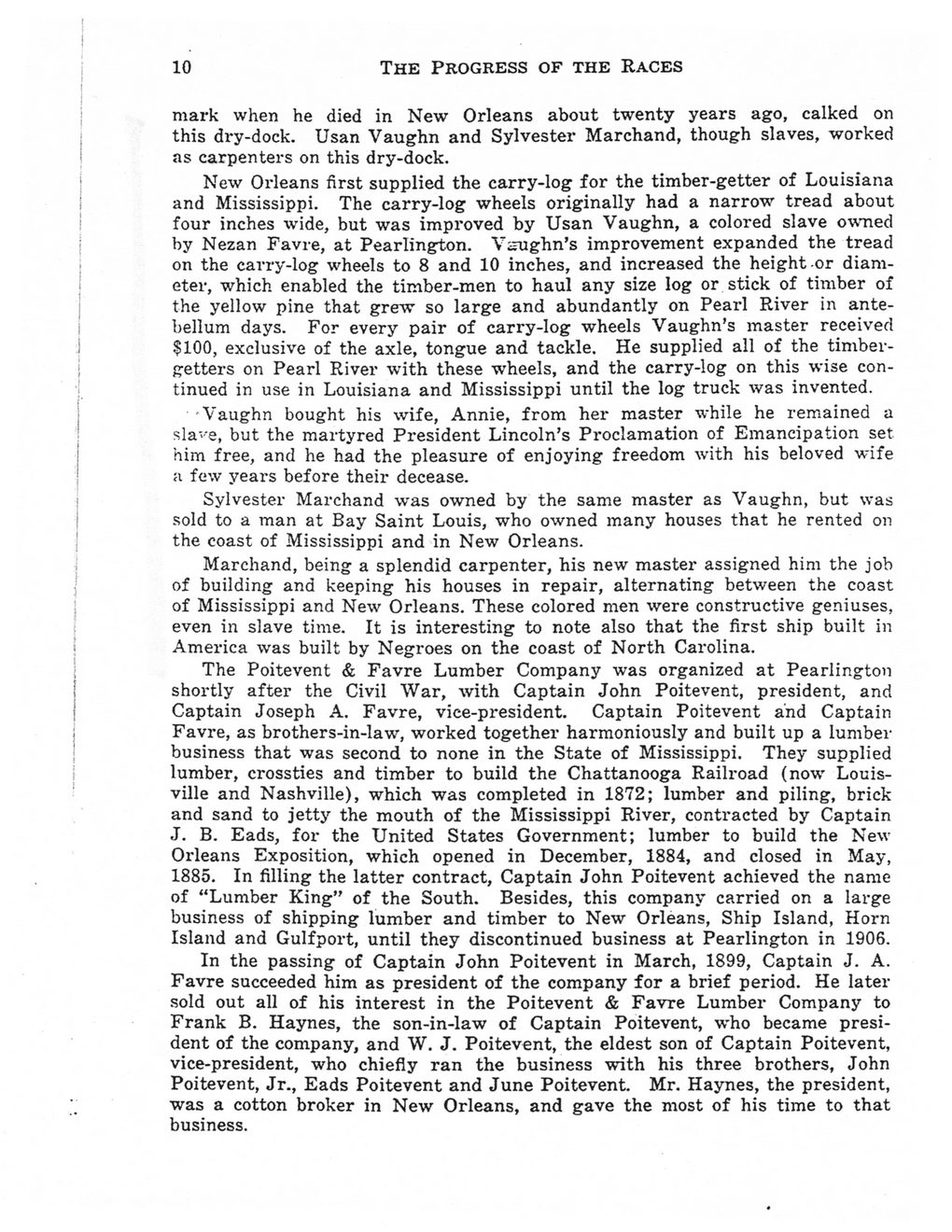This text was obtained via automated optical character recognition.
It has not been edited and may therefore contain several errors.
10 The Progress of the Races mark when he died in New Orleans about twenty years ago, calked on this dry-dock. Usan Vaughn and Sylvester Marchand, though slaves, worked as carpenters on this dry-dock. New Orleans first supplied the carry-log for the timber-getter of Louisiana and Mississippi. The carry-log wheels originally had a narrow tread about four inches wide, but was improved by Usan Vaughn, a colored slave owned by Nezan Favre, at Pearlington. Vinighn?s improvement expanded the tread on the cavry-log wheels to 8 and 10 inches, and increased the height or diameter, which enabled the timber-men to haul any size log or stick of timber of the yellow pine that grew so large and abundantly on Pearl River in antebellum days. For every pair of carry-log wheels Vaughn?s master received $100, exclusive of the axle, tongue and tackle. He supplied all of the timber-getters on Pearl River with these wheels, and the carry-log on this wise continued in use in Louisiana and Mississippi until the log truck was invented. ?Vaughn bought his wife, Annie, from her master while he remained a sla^e, but the martyred President Lincoln?s Proclamation of Emancipation set him free, and he had the pleasure of enjoying freedom with his beloved wife a few years before their decease. Sylvester Marchand was owned by the same master as Vaughn, but was sold to a man at Bay Saint Louis, who owned many houses that he rented on the coast of Mississippi and in New Orleans. Marchand, being a splendid carpenter, his new master assigned him the job of building and keeping his houses in repair, alternating between the coast of Mississippi and New Orleans. These colored men were constructive geniuses, even in slave time. It is interesting to note also that the first ship built in America was built by Negroes on the coast of North Carolina. The Poitevent & Favre Lumber Company was organized at Pearlington shortly after the Civil War, with Captain John Poitevent, president, and Captain Joseph A. Favre, vice-president. Captain Poitevent and Captain Favre, as brothers-in-law, worked together harmoniously and built up a lumber business that was second to none in the State of Mississippi. They supplied lumber, crossties and timber to build the Chattanooga Railroad (nowT Louisville and Nashville), which was completed in 1872; lumber and piling, brick and sand to jetty the mouth of the Mississippi River, contracted by Captain J. B. Eads, for the United States Government; lumber to build the New Orleans Exposition, which opened in December, 1884, and closed in May, 1885. In filling the latter contract, Captain John Poitevent achieved the name of ?Lumber King? of the South. Besides, this company carried on a large business of shipping lumber and timber to New Orleans, Ship Island, Horn Island and Gulfport, until they discontinued business at Pearlington in 1906. In the passing of Captain John Poitevent in March, 1899, Captain J. A. Favre succeeded him as president of the company for a brief period. He later sold out all of his interest in the Poitevent & Favre Lumber Company to Frank B. Haynes, the son-in-law of Captain Poitevent, who became president of the company, and W. J. Poitevent, the eldest son of Captain Poitevent, vice-president, who chiefly ran the business with his three brothers, John Poitevent, Jr., Eads Poitevent and June Poitevent. Mr. Haynes, the president, was a cotton broker in New Orleans, and gave the most of his time to that business.

Vaughan, Usan 007